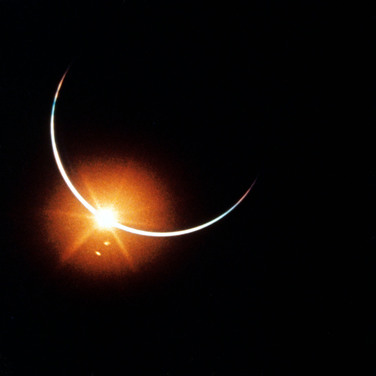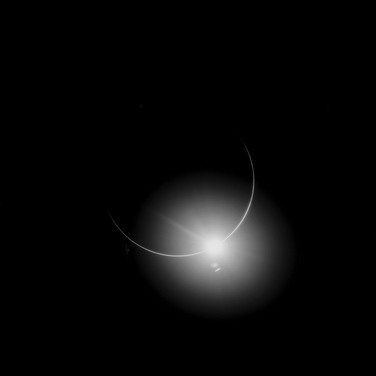Just a few hours before the crew splashed down in the Pacific Ocean at a distance of 54,000 km (33,500 miles) from Earth, they observed and photographed a spectacular eclipse of the sun by the Earth, something visible only from space.
Here is the exchange between the astronauts and Capsule Communicator and fellow astronaut Paul Weitz in Mission Control.
Gordon: Hello, Houston; Apollo 12.
Weitz: Go ahead, 12.
Gordon: We're getting a spectacular view at eclipse. We're using the sun filter for the G&N (Guidance and Navigation) optics, looking through, and it's unbelievable.
Weitz: Roger. Understand, Dick.
Gordon: The reason it looks so much different is the limb of the Earth is eclipsing it. It's not quite a straight line, but it's certainly a large, large disk right now. Looks quite a bit different than when you see the moon eclipse the sun.
Weitz: Roger.
Bean: Anybody down there know how I - what we can set the camera at to use the sun filter on it? To - to - take a couple of shots of this eclipse right through it?
Weitz: Stand by and we'll check.
Bean: They'd better hustle.
Weitz: Okay.
Bean: Funny thing is, you cannot see the Earth at all when you just shield your hand from the sun and look out right next to it where the Earth should be. It's not there at all. When you stick your smoked glass up, you can see where it's cutting the - the sun. Otherwise, it's completely invisible.
Weitz: Roger, Al.
Bean: Fantastic sight. What we see now is - The sun is almost completely eclipsed now, and what it's done is illuminated the entire atmosphere all the way around the Earth, even though the sun is still on what looks like the western limb of the moon - the Earth to us.
Bean: But the diameter of the Earth now looks compared - to the moon - I'd say about 15 times the diameter of the sun; but it's illuminating the whole atmosphere all the way around. It really looks pretty. You can't see the Earth. It's black just like the - space.
Weitz: Roger. Understand you cannot make out the Earth at all.
Bean: No. You can't see any features on it. All you can see is this sort of purple-blue, orange, some shades of violet, completely around the Earth. It's illuminated.
Conrad: It's very interesting looking at the atmosphere. It has blues and pinks in it, but instead of being banded, it's segmented, which is very peculiar; I don't understand why. It may be the difference between over the landmasses and water or something.
Weitz: Roger, Pete. Understand. Is it kind of like you would see in the desert in the evening sometimes when you get that blue and pink streaking in the sky?
Conrad: Yes. Except, like I say, it’s segmented for about - Right from the sun, around about a quarter of the Earth is pure blue, and then it becomes pink to about 20 degrees of arc; and then it turns back to blue again. And it's blue all the way around the bottom - to where it turns pink again, and then it turns blue again.
Bean: It looks - It looks like this is going to have a luminated atmosphere, probably the whole time it's eclipsed. What it looks like now through the smoked glass is that the sun is completely set behind the Earth, and you probably know better than I do from some...
Bean: Roger. We're using it at 1/60th at 1 frame a second and I - using 1.4 f-stop and also at 2 - and what - and a 1. What it looks like is the sun is set, but it's so close to the limb of the moon on the backside there, that that bright light is being channeled through the atmosphere, and so if you look at it with a naked lie – eye you can't tell the sun is set yet. Through the smoked glass, you can see that it's no longer a disk there, but you just see a bright white line the diameter of the sun.
Weitz: Roger, Pete. Understand. Al.
Gordon: We're shooting these at 1/60th at 1.4, and that's where we're going to stay unless you come up with a better suggestion.
Weitz: Roger. We got that, Dick; 1/60th, 1.4 at 1 frame a second. They're working on it in the back room and, actually according to our figures here, you should still be seeing a little piece of the sun. You don't enter the full umbra until a little after 241 GET.
Gordon: You’re absolutely correct. We still have a little bit of sun through the horizon on the western limb.
Weitz: Roger.
Gordon: But right now, the Earth is completely – the atmosphere of the Earth is completely illuminated all the way around, 360, and right in the center it's as black - it's as dark at the –as space behind it itself. This is really spectacular.
Weitz: Roger.
Gordon: Have you got any more adjectives for spectacular? I'd like to use some if you have.
Weitz: No. We'll put somebody to work on that, too.
Weitz: Hello, 12; Houston. You’re taking these pictures through the optics, right?
Gordon: Negative, Houston. Through the hatch window.
Bean: This has got to be the most spectacular sight of the whole flight. We can see now that the sun's behind the Earth. We can see clouds sort of on the dark part of the Earth; and, of course, the Earth's still defined by this thin narrow - or thin blue-and-red segmented band. It's a little bit thicker over at the - down where the sun just set than it is at the other one, but it is really a fantastic sight. The clouds appear sort of pinkish gray, and they're sort of scattered all the way around the Earth. It would be interesting to know exactly what part of the Earth we're looking at or what our nadir is now, because that part doesn't appear to have any clouds, and these others appear to be sort of revolving around it.
Weitz: Roger, Al. Understand that you can see clouds all the way around the Earth including the dark portion of it, and your nadir right now is just about the Indian Ocean.
Conrad: Well, the whole - the whole Earth is dark to us. We looking at the night side, but we can see all the clouds. We haven't been able to distinguish landmasses yet, but we might be able to in a minute when we get a little bit better adapted, and I think the airglow is illuminating the clouds down there.
Weitz: Roger, Pete.

